This summer, my family and I stayed near Leiwen, in Germany, a small town on the right bank of the river Moselle. One of the things I like to notice in a landscape are tracks of a recent past, which are invisible, unless you look very carefully. In this case, it became clear to me that once there was a railway: in Leiwen there exists a Bahnhofstrasse (Station street). I found the evidence in the Heimatmuseum in the town of Neumagen-Dhron (first picture). There is a room dedicated to the history of the line, once known as the Moselbahn. Of course the museum contains also rooms dedicated to the wine business, and to the rich Roman history of this district.
After seeing the photographs in the small exibition, I came to realise that the strange arched wall alongside the road Leiwen – Neumagen (picture at right, near Trittenheim) was in fact the remaining understructure of the former railroad.
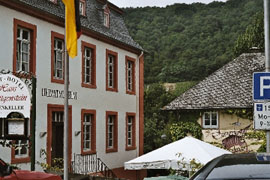
The Heimatmuseum (district’s museum) of Neumagen-Dhron, with in the back, the forest and vineyards across the Moselle.
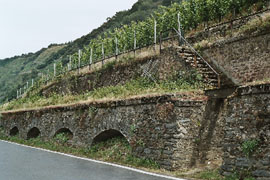
The remaining understructure of the railway track, near Trittenheim, with on the right, in the middle, the remains of a small, metal viaduct (see next picture)
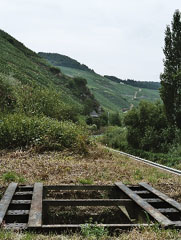
The remains of a small viaduct, in the direction of Leiwen, now in use as an unofficial lavatory to the many cyclists…
A few days later, during a brief visit to Bernkastel-Kues, we left our car in the busy car-park on the river bank, where the ferries embark. That happened to be the former station yard, with the Railway station turned into a restaurant.
The Moselle track has been partly turned into a cycle path. And very popular too, as it offers a beautiful, scenic view of the Moselle valley, with its forests and vineyards, and all the small towns.
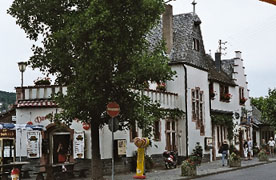
The former Station of Bernkastel, now turned into a restaurant.
History of the Moselbahn
The first track, Trier-Leiwen, was opened on 2 April 1903, with the final track, Bernkastel-Bullay, opened 19 Augst 1905 (link to info on the complete track). The track was built, after long discussions (in German), as standard gauge. Link to an overview of literature on this railway. There exists a video from an SFB tv-series. Here an interview (in German, dated 16 March 2002) with the last driver, Otto Heydt.
The railway played an important role in the development of the Moselle wine-industry. It was shut down in the sixties, like so many other railways, with the last track, Trier-Neumagen, being closed on 31 January 1968.
That was the end of a railway which time-table read like a wine-card. Only who looks carefully at the landscape now, will catch a glimpse of its old glory.
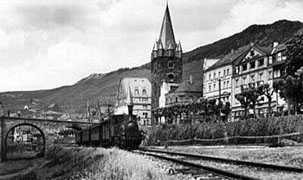
Bernkastel-Kues, 1930

One Response to Moselbahn